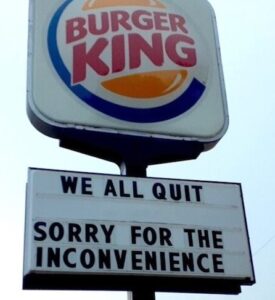 America experienced mass strikes after the end of both world wars. For example, in 1946, 10% of the U.S. workforce struck employers. The reason? Companies had made a lot of money during the war, and they wanted their share.
America experienced mass strikes after the end of both world wars. For example, in 1946, 10% of the U.S. workforce struck employers. The reason? Companies had made a lot of money during the war, and they wanted their share.
What makes a “mass strike” different from an ordinary strike is that labor unrest isn’t confined to a single employer and its workers. Sometimes “major waves of strikes” occur, usually tied to “shattering events” like wars or depressions. The Covid-19 pandemic is such an event.
It has affected nearly every American, killed nearly a million of us (a number likely to be reached soon), and disrupted countless businesses. And by now, just about everyone who follows the news is aware of a phenomenon the media has dubbed “The Big Quit”: Millions of American workers are voluntarily chucking their jobs. Some are taking better jobs, some are opting for self-employment, some are retiring, and others are simply staying home. It’s having a big impact on employers, who can’t hire enough workers, and the economy.
In October 2021, with the year only a little over three-quarters over, CNBC estimated 25% of America’s workers had already quit their jobs (see story here). In the next month alone, November 2021, “a staggering 3 percent of the U.S. workforce quit,” according to Mother Jones (see story here).
This mass revolt was preceded by decades of mistreatment of workers, stagnating wages while corporate profits soared, and systematic shredding of the social safety net. Workers were suffering from burnout, “general malaise,” and felt disrespected and not listened to. Then came the pandemic, which first brought temporary business shutdowns, then a concerted push by business-friendly GOP politicians to force workers back into unsafe workplaces and unsafe working conditions.
There were a few strikes, but not many, as the unions had largely been destroyed. The workers, as Mother Jones puts it, just “up and quit. … Millions of people decided they were done.”
Conservative politicians and media tried to portray them as “lazy” for refusing “to work a crap job for low pay.” Based on what you know about human nature, do you think that approach will get people to respond to “We’re Hiring” signs, or make them even angrier?
An MIT economist wrote in the New York Times that the United States has “generated vast numbers of low-paid, economically insecure jobs.” Mother Jones says, “Recent reporting shows workers are pissed off and burned out. … From white-collar workers reconsidering their life priorities, to service industry staff tired of dealing with terrible customers, to low-wage laborers finding solidarity against the shit conditions laid bare by the pandemic, people are broadly opting out.” For many of those workers, it boiled down to “this isn’t worth it.”
Assuming people still have to make a living, and these workers eventually will work again, that sure looks like a mass strike.
A University of Michigan economist cited by Mother Jones called it a “sort of collective bargaining situation,” as in, We want a better deal, or we won’t work. “Quitting,” Mother Jones says, “is in some ways, the sad resort of an individualized working class.” Without a union, all you can do is quit. In that sense, quitting is a proxy or substitute for striking.
There’s a possibility that workers now will win better wages and what Mother Jones calls “institutional reforms.” But the Big Quit could also prove to be short-lived and bring political backlash. Republicans are already blaming inflation on rising wages, and plan to use inflation as a centerpiece in their 2022 midterm campaigns. There’s a feeling in the air, though, that something has changed and things won’t go back to the way they were. It just may be that a long-simmering reckoning for employers has come, probably inevitable eventually, but its arrival hastened by the pandemic.